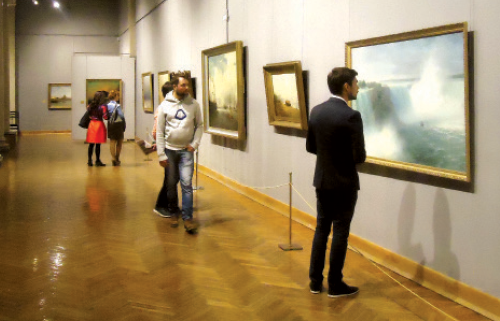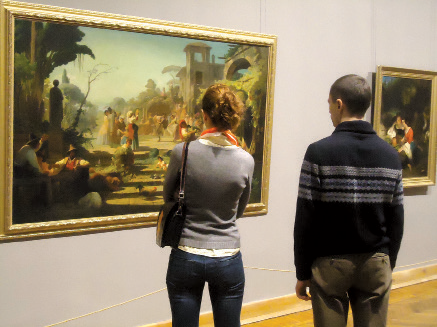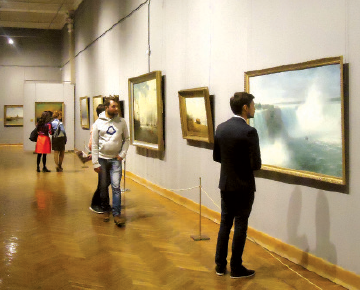By Victor Mikhailov
Surveying the pictures at the exhibition, I felt quite as if I must be in the Hermitage or, perhaps, the Tretyakov Gallery. I was looking at real masterpieces of Russian art. There were at least ten works by well-known seascape painter Ivan Aivazovsky.

Exhibition of 19th century academic paintings from National Art Museum of Belarus
Art critics assert that the National Art Museum of Belarus stores one of the best collections of academic painting across the former USSR, as confirmed by the present exhibition.
Ivan Aivazovsky’s works are truly outstanding, and only improve on acquaintance, such is his mastery and convincing interpretation of natural landscapes. He portrays truth via lofty and heroic motives, based on his feelings and memories. He is deservedly among the purest masters of early-19th century Russian academic painting. He once said that those with the best memories may make excellent copies of real life, as in a photograph, but will never be true artists. He advocated that living elements’ movements were ‘imperceptible to the brush’ and advised ‘to paint the light, a gust of wind or the splashing of waves is impossible from nature’. “The artist must remember them, using light and shade to arrange the picture,” he asserted.

Visual acquaintance with painters’ mastery
 On show in Minsk are Ivan Aivazovsky’s Storm (1852), Marina (1858), Foggy Morning (1853) and Morning at Sea (1883). The exhibition at the National Art Museum also boasts works by his contemporaries: Pavel Tizengauz’s Storm (1876), Alexey Bogolyubov’s Parade of the Russian Fleet (1888), Lev Lagorio’s On the Sea Shore (1871) and Caucasus (1869). The simple yet emotionally powerful images are filled with their own radiance.
On show in Minsk are Ivan Aivazovsky’s Storm (1852), Marina (1858), Foggy Morning (1853) and Morning at Sea (1883). The exhibition at the National Art Museum also boasts works by his contemporaries: Pavel Tizengauz’s Storm (1876), Alexey Bogolyubov’s Parade of the Russian Fleet (1888), Lev Lagorio’s On the Sea Shore (1871) and Caucasus (1869). The simple yet emotionally powerful images are filled with their own radiance.Besides landscapes, there are also historical canvases on display, including those with biblical themes — such as Abraham’s Sacrifice (1870-1880), and works devoted to the Middle Ages. Scenes from the 17th-century Russian ‘boyar way of life’ are a national feature of Russian academic painting — as represented by Georgy Urlaub’s Boyar (1898) and Vladimir Makovsky’s Boyarynia (1880).
One section of the exhibition explores the ‘Italian’ genre: Pimen Orlov’s Near a Well (1843), Fiodor Bronnikov’s God Will Give You Alms (1859), and A Reception with the Pope (1869), Ivan Reimers’ Vintage in the Vicinities of Rome, and Faddei Goretsky’s Entrance into St. Peter’s Basilica (1854). They may lack psychological depth, but they have other, unquestionable advantages. Italy appears as a paradise on Earth, alive with the beauty of nature and architecture, and flush with
 bright southern light and colours. We feel the Italians’ enjoyment of each moment of life, set against a backdrop of magnificent scenery, architecture, poetic ruins and, certainly, beautiful Italian women.
bright southern light and colours. We feel the Italians’ enjoyment of each moment of life, set against a backdrop of magnificent scenery, architecture, poetic ruins and, certainly, beautiful Italian women.The exhibition also features timeless portraits by true masters: Alexey Tyranov’s Portrait of E.I. Ton (1844-1845), Sergey Zaryanko’s Portrait of Georgian Princess Anna Alekseevna (1856), and Timofei Neffa’s Portrait of a Boy (1850). Their skill lies in their meticulous attention to detail and sincerity, combined with rich composition and colour. Each image carries an internal nobility, regardless of skill of execution.
Without exaggeration, the works now exhibited at Belarus’ foremost gallery will be loved and enjoyed by all who view them. Such academic painting is the epitome of artistic mastery.











